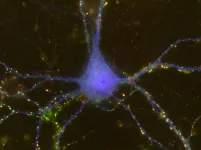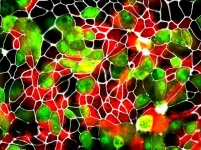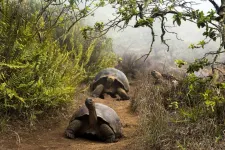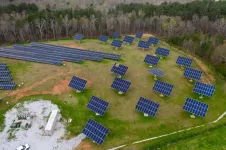Scientists uncover drivers of phenotypic innovation and diversification in gymnosperms
2021-07-19
(Press-News.org) Determining the major drivers of species diversification and phenotypic innovation across the Tree of Life is one of the grand challeges in evolutionary biology.
Facilitated by the Germplasm Bank of Wild Species of the Kunming Institute of Botany (KIB) of the Chinese Academy of Sciences (CAS), Prof. YI Tingshuang and Prof. LI Dezhu of KIB led a novel study on gymnosperm diversification with a team of international researchers.
This study provides critical insight on the processes underlying diversification and phenotypic evolution in gymnosperms, with important broader implications for the major drivers of both micro- and macroevolution in plants.
The results were published today online in Nature Plants in an article entitled "Gene duplications and phylogenomic conflict underlie major pulses of phenotypic evolution in gymnosperms."
In green plants, it is well understood that whole-genome duplication (WGD, or polyploidization) is an important evolutionary force. However, scientists have not clearly understood the role of WGD in shaping broad-scale evolutionary patterns in plants, especially when WGD is combined with adaptive radiation and other processes arising from climate change or new ecological opportunities.
Likewise, extant gymnosperm lineages clearly exhibit a complex history of ancient radiations, major extinctions, extraordinary stasis, and recent diversification. However, the correlates and causes of major phases of gymnosperm evolution have also not been well understood.
Using a novel transcriptome dataset as well as a diversity of comparative datasets, the researchers examined the relationship between various facets of genomic evolution, including gene and genome duplication, genome size, and chromosome number, and macroevolutionary patterns of phenotypic innovation, species diversification, and climatic occupancy in gymnosperms.
The scientists showed that spikes of gene duplication typically coincide with major spikes of phenotypic innovation, representing one of the first demonstrations of a direct relationship between gene duplication and phenotypic innovation on a macroevolutionary scale.
They also found that most shifts in gymnosperm diversification, since the rise of angiosperms, were decoupled from WGD events and instead are associated with increased rates of climatic occupancy evolution in cooler and/or more arid climatic conditions.
This suggests that ecological opportunity, especially in the late Cenozoic, along with environmental heterogeneity have driven a resurgence of gymnosperm diversification.
INFORMATION:
This work was funded by the Strategic Priority Research Program of CAS and the large-scale scientific facilities of CAS.
[Attachments] See images for this press release:
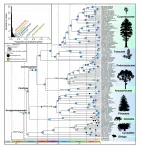
ELSE PRESS RELEASES FROM THIS DATE:
2021-07-19
HUNTINGTON, W.Va. - During development, brain cells may find different ways to connect with each other based on sex, according to researchers at the Marshall University Joan C. Edwards School of Medicine.
The study, recently published in eNeuro, an open access journal for the Society of Neuroscience, showed a significantly more robust synaptogenic response in male-derived cells compared to female-derived cells when exposed to factors secreted from astrocytes, which are non-neuronal cells found throughout the central nervous system. This difference was driven largely by how neurons responded to thrombospondin-2 (TSP2), a protein with cell adhesion properties that is normally secreted by astrocytes. ...
2021-07-19
Since the beginning of the pandemic, several reports have indicated that SARS-CoV-2 spillover events have occurred from humans to animals, as evidenced by the transmission of the virus between keepers and tigers and lions in the Bronx Zoo in New York. However, to date, the full range of animal species that are susceptible to SARS-CoV-2 infection remains unclear. Typically, such information could be obtained by experimentally infecting a large variety of animal species with SARS-CoV-2 to see if they are susceptible. However, in order to reduce and refine such animal experiments, the researchers at the University of Bern and at the IVI set out to answer this question ...
2021-07-19
A new study published in Accident Analysis & Prevention shows how biometric data can be used to find potentially challenging and dangerous areas of urban infrastructure before a crash occurs. Lead author Megan Ryerson led a team of researchers in the Stuart Weitzman School of Design and the School of Engineering and Applied Science in collecting and analyzing eye-tracking data from cyclists navigating Philadelphia's streets. The team found that individual-based metrics can provide a more proactive approach for designing safer roadways for bicyclists and pedestrians.
Current federal rules for installing safe transportation interventions at an unsafe crossing--such as a crosswalk with a traffic signal--require either a minimum of 90-100 pedestrians crossing this location every hour ...
2021-07-19
COLUMBUS, Ohio - Flavor is the name of the game for scientists who want to optimize food for consumption in ways that improve nutrition or combat obesity.
But there is more to flavor than the substances that meet the mouth. Olfaction, our sense of smell, is a major contributor to how we perceive aromas, especially those related to what we eat.
With hopes to capitalize on the smell factor in flavor development, researchers are exploring how the route an aroma takes to get to the olfactory system, through the nose or the back of the throat, influences our response to the scent in question.
In a new study, when participants were asked to match a known scent such as rose with one of four unknown scents, they did best when the aromas were introduced ...
2021-07-19
Champaign, IL, July 19, 2021 - For dairy cows, the transition period--the time between a cow giving birth and beginning to produce milk--brings the greatest possibility of health problems. The current widespread belief is that the effects of excess nonesterified fatty acids (NEFA) in the bloodstream and the ensuing hyperketonemia during this period, coupled with low levels of available calcium, are largely responsible for disorders such as mastitis, metritis, retained placenta, and poor fertility. Much attention has therefore been devoted to regulating NEFA and calcium levels in transition cows--yet all these efforts have not made the transition period less of a challenge to cows and, hence, to farmers, with approximately ...
2021-07-19
The second dose of a COVID-19 vaccine induces a powerful boost to a part of the immune system that provides broad antiviral protection, according to a study led by investigators at the Stanford University School of Medicine.
The finding strongly supports the view that the second shot should not be skipped.
"Despite their outstanding efficacy, little is known about how exactly RNA vaccines work," said Bali Pulendran, PhD, professor of pathology and of microbiology and immunology. "So we probed the immune response induced by one of them in exquisite detail."
The study, ...
2021-07-19
The MOMAT research group from Universidad Complutense de Madrid has worked with Universidad de Almería, to develop a mathematical model that simulates the impact of SARS-CoV-2 strains and vaccines together, combined with many other biological and social processes in the propagation of COVID-19.
The tool can be downloaded without restriction and free of charge and applied to any territory. It forms part of the family of θ-SIR models, which were initially developed by the MOMAT research group itself before the arrival of new variants and the development of vaccines.
"The model allows us to estimate for the first time ...
2021-07-19
UCC-UCM, 13 July. The Giant Galapagos tortoises which live in contact with human farming and tourism activities, or in urbanised zones, have more bacterial resistance to antibiotics than those that live in more isolated ecosystems.
This is the main conclusion of the research published in Environmental Pollution on which Universidad Complutense de Madrid participated together with the Charles Darwin Foundation (FCD), the Institute for Conservation Medicine of the Saint Louis Zoo (ICM), the Centre for Animal Health Research (INIA-CISA) and Universidad Europea de Madrid.
Ainoa Nieto, the lead author, researcher at ICM/FCD and collaborator ...
2021-07-19
Analysis of children and young people's proximity to woodlands has shown links with better cognitive development and a lower risk of emotional and behavioural problems, in research led by UCL and Imperial College London scientists that could influence planning decisions in urban areas.
In what is believed to be one of the largest studies of its kind, researchers used longitudinal data relating to 3,568 children and teenagers, aged nine to 15 years, from 31 schools across London. This period is a key time in the development of adolescents' thinking, reasoning and understanding of the world.
The study, published in Nature Sustainability, looked at the links between different types of natural urban environments and ...
2021-07-19
When it comes to transitioning from carbon-based to renewable source energy systems, Americans are on board. They're less keen, however, having these new energy infrastructures--wind turbines or solar farms--built close to their homes, which creates hurdles for policymakers. That's according to a study from University of Georgia researcher Thomas Lawrence.
Lawrence and an international team conducted surveys in the United States, Germany and Ireland to assess people's attitudes about renewable energy technologies and their willingness to have the necessary infrastructures built nearby.
"People in Germany and Ireland were more open to having renewable ...
LAST 30 PRESS RELEASES:
[Press-News.org] Scientists uncover drivers of phenotypic innovation and diversification in gymnosperms

